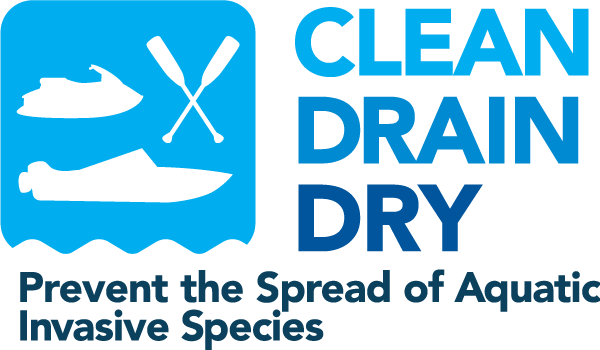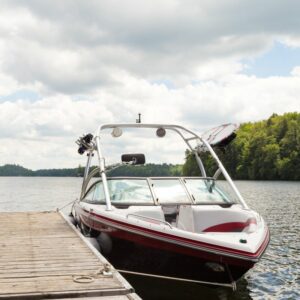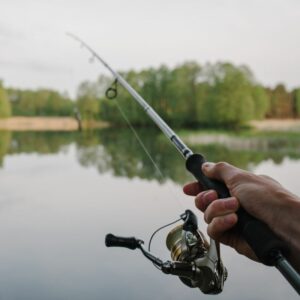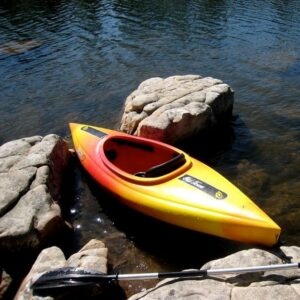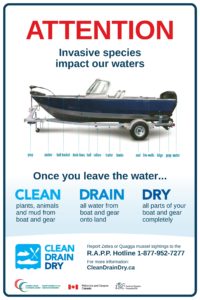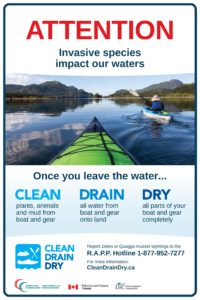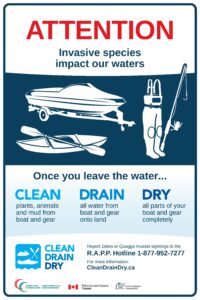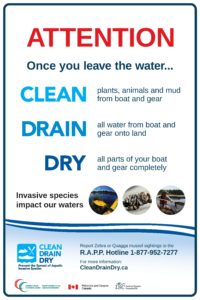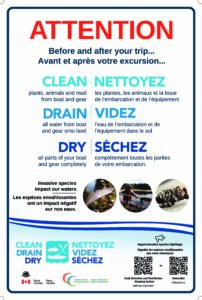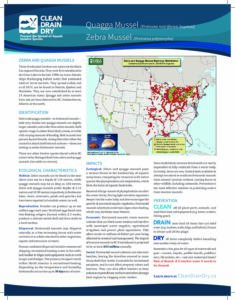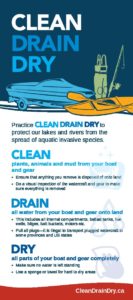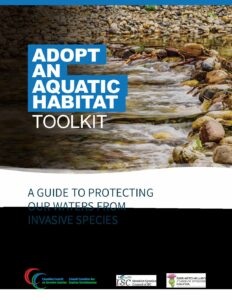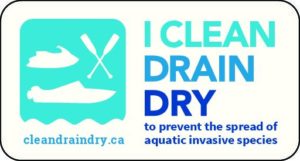Join other water recreation enthusiasts in Canada protecting the waterways we love by practicing the simple steps of Clean Drain Dry.
Clean Drain Dry Steps
Aquatic invasive plants, animals, and diseases can spread through water-based recreation when they cling to our watercrafts and gear. These species spread alarmingly fast and threaten Canada’s waterways including recreational areas, aquatic habitat and species, and drinking water and drainage infrastructure we rely on. Follow the Clean Drain Dry steps and best practices to protect water resources and stop the spread of aquatic invasive species in Canada:
Clean
Inspect and clean plants, animals, and mud from watercraft, trailer, and gear (fishing gear, waders, boots, etc).
Drain
Drain all water from your watercraft, trailer, and gear (e.g. buckets, well, bilge, ballast etc.).
Dry
Dry all parts of your watercraft, trailer and gear completely between trips.
Follow these best practices to protect the health of our waterways:
- CLEAN, DRAIN, and DRY all watercraft, trailer, motors, and gear every time, everywhere.
- NEVER release or move fish, animals, or plants from one waterbody into another.
- LEARN to recognize aquatic invasive species and report them.
- INFORM others about the threat of aquatic invasive species.
Note: Provinces and territories have varying regulations and requirements when it comes to requirements for cleaning, draining and drying to stop aquatic invasive species. Learn more about your own province’s or territories rules and regulations below.
Practice these steps whenever you go on, in, or near water – when you’re angling, boating, kayaking, canoeing, paddle boarding, using waders, etc.
Back to topTake the Pledge!
Do you want to be a part of protecting Canada’s waterways? It’s never too late to start taking the Clean Drain Dry steps to protect our waters, every act helps!
Join 100’s of others across North America who have pledged to protect the places we love. Committing to action is a tool used to help people build habits and commit to changes in their behaviour. The pledge is a reminder and a statement about how you value Canada’s resources. When you pledge to always take the Clean Drain Dry steps when enjoying the outdoors, you have a greater chance of adhering to your commitment during your next and future outdoor adventures!
Complete the pledge form below and your name will be added to list of other individuals preventing the spread across Canada.
Clean Drain Dry Tools
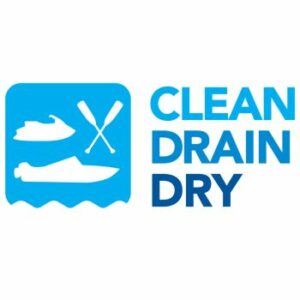 Become a Program Partner Gain access to nationally recognized branding and partner resources to implement locally.
Become a Program Partner Gain access to nationally recognized branding and partner resources to implement locally. 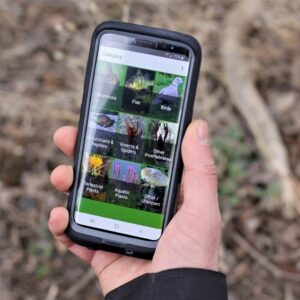 Report Invasive Species Support early detection and response in your community by reporting sightings.
Report Invasive Species Support early detection and response in your community by reporting sightings.  Subscribe to our E-newsletter Receive updates on invasive species news, events, programs, and resources.
Subscribe to our E-newsletter Receive updates on invasive species news, events, programs, and resources. 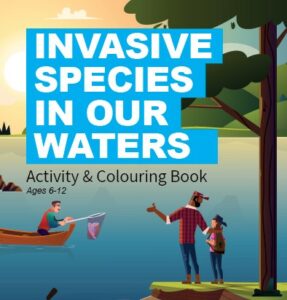 Access Free Youth Resources Visit our resources page for more details.
Access Free Youth Resources Visit our resources page for more details. Resource Library
The resources below are a sample of the resources available to program partners who help implement Clean Drain Dry messaging and resources including boat launch signs, decals, rack cards, factsheets, and more. All resources are available in English, French, and/or with bilingual wording.
Note: Resources can be tailored to suit the rules and regulations of a province or territory after joining as a partner.
Visit our “Become a Partner” page to learn more!
Other Provincial & Territorial Requirements Across Canada
The National Clean Drain Dry program is not meant to replace existing programs across Canada, but rather to supplement them. Many provinces and territories also have their own regulations and requirements regarding aquatic invasive species and transportation of watercraft. Read below to find your provincial or territorial program and associated regulations and requirements.
Alberta
Alberta has taken great strides to address one of the largest threats to freshwater resources in the West – Aquatic Invasive Species (AIS). These pests have the potential to cause severe damage to our environment, economy and society. To combat the risk of an AIS infestation, a remarkable partnership of government, stakeholders and industry has built an intricate system where none existed just 10 years ago.
Within the Ministry of Environment and Parks, the Alberta Aquatic Invasive Species (AIS) Program is led by the Fish and Wildlife Policy Division. It is important to note that the success of the program would not be possible without the overwhelming support and delivery provided by Operations Infrastructure (watercraft inspections), Alberta Support and Emergency Response Team (ASERT – response planning), the Environmental Monitoring and Science Division (EMSD – monitoring), Parks (education, monitoring and roving inspections), Community Engagement Branch (graphic design, education strategies and materials), and Communications (social media and advertising). While there are only three dedicated full-time staff in the AIS program, many passionate and dedicated individuals have committed substantial time and support to this effort. In this sense, the program benefits from a phenomenal amount of “in kind” support, from both cross-ministry government staff, as well as essential non-government stakeholders.
The Alberta AIS Program includes five elements:
- Policy and Legislation,
- Watercraft Inspections,
- Education and Outreach,
- Monitoring, and
- Response.
For more information visit their website.
Aquatic Invasive Species Reporting 1 855 336 BOAT (2628)
Email the AIS Program here.
British Columbia
If you are transporting a watercraft in B.C. it is mandatory to stop and report to all invasive mussel watercraft inspection stations along your travel route. For more information about the BC Watercraft Inspection Stations please click HERE.
Report suspected contaminated boats carrying invasive mussels that may be travelling from out-of-Province to the RAPP line (1-877-952-7277). If you’re bringing your boat from out-of-province, contact the Provincial Program at COS.Aquatic.Invasive.Species@gov.bc.ca to determine if your boat is HIGH-RISK and should be decontaminated for possible zebra or quagga mussel presence before accessing B.C.’s lakes and rivers. It’s free! Transporting live or dead Zebra/Quagga mussels into B.C. is a provincial offence under the Controlled Alien Species (CAS) Regulation under the Wildlife Act.
For more information about other invasive species please click HERE.
Manitoba
To protect Manitoba’s waters and valuable aquatic resources from the introduction and spread of aquatic invasive species (AIS) such as zebra mussels, visit Manitoba.ca/StopAIS by clicking here.
Here you can learn about:
- how to be compliant with Manitoba’s specific provincial requirements during the open-water and winter (closed-water) seasons,
- AIS Control Zones,
- importation rules,
- watercraft inspection schedules and
- set-fines for AIS offences.
Saskatchewan
If you are transporting a watercraft into, or within Saskatchewan, it is mandatory to remove the drain plug prior to transport and to stop at all watercraft inspection stations you encounter in your travels.
If you’re are coming from, or returning home from out-of-province, contact the Ministry of Environment 1-800-567-4224 to determine if your boat is HIGH-RISK and should be inspected (and possibly decontaminated) for aquatic invasive species such as zebra and quagga mussels, prior to accessing Saskatchewan’s lakes and rivers. Transporting live or dead Zebra/Quagga mussels into Saskatchewan is a provincial offence under The Fisheries Regulations.
For more information about other invasive species click here.
Back to top
